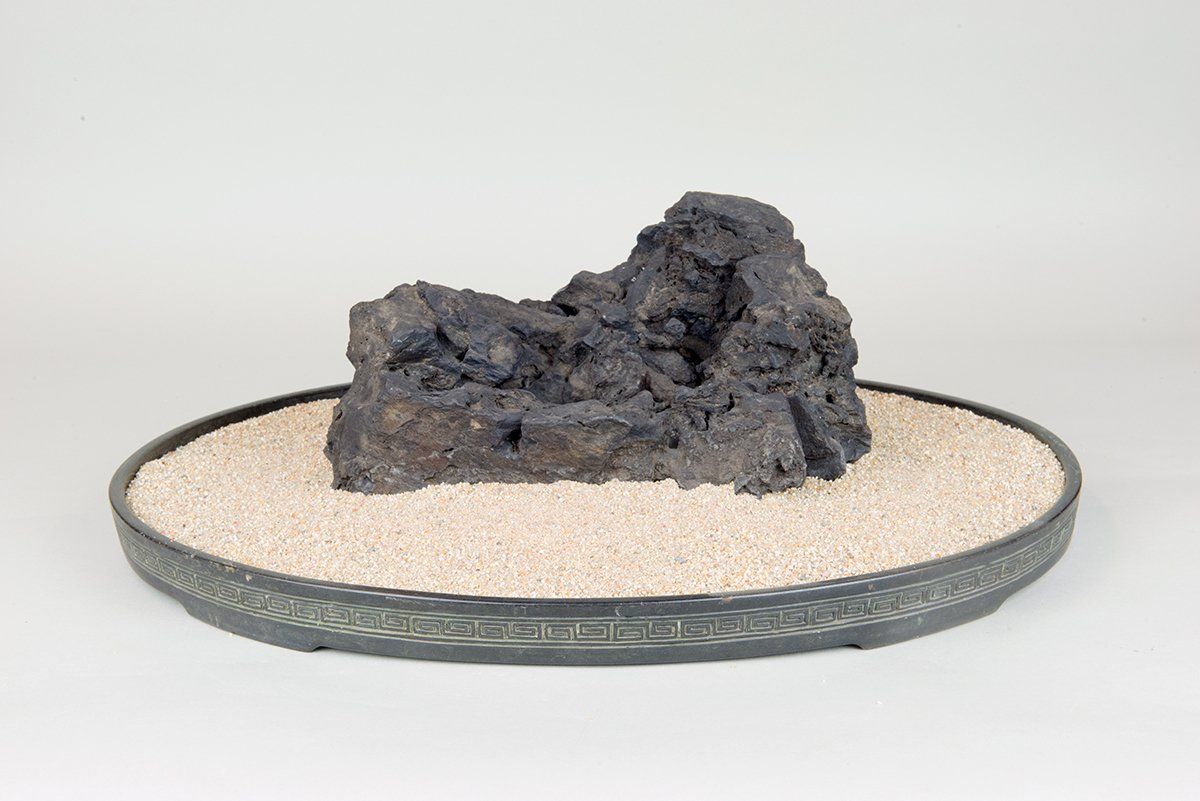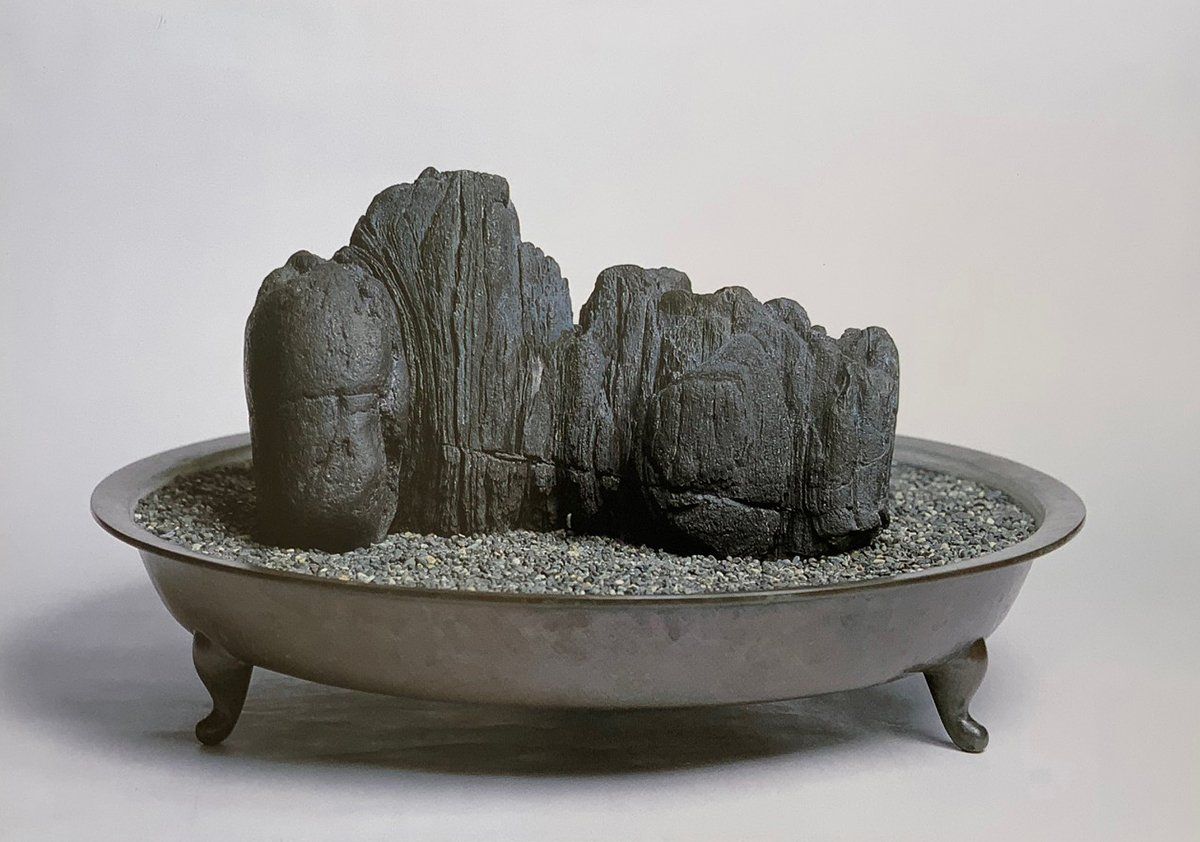The Iwasaki Family Numbered Stones
Important information about the Iwasaki Family Numbered stones is presented in this detailed account.
By Hiromi Nakaoji, October, 2021
The Iwasaki Family Numbered Stones are famous and historically important Japanese suiseki because they were owned by the family that established the industrial giant Mitsubishi Corporation. The stones had rugged features and a provenance of ownership that extends over 100 years. Once they left the Iwasaki family and became available to others in 1963, the stones were highly sought after by suiseki hobbyists. The new owners wanted to display them in their national Meihin-ten in Tokyo, especially in the 1970s.
The stones are called Iwasaki Family Numbered Stones because each stone is numbered on the bottom.
To understand the history of the Iwasaki Family Numbered Stones, we have to understand the Iwasaki Family. Iwasaki Yataro was the first president of the Mitsubishi Corporation, and Iwasaki Yanosuke, the younger brother, succeeded him in 1885 when Yataro passed. Yanosuke set up Mitsubishi Joint Venture to place the Mitsubishi Corporation in a more solid position.
Yanosuke later served as president of the Bank of Japan and became Baron Iwasaki. Both brothers loved bonsai and suiseki. Yanosuke became a well-known collector. One of the stories about Yanosuke is the way he purchased bonsai. When he first visited the Hyakuso-en Nursery in Toyko, he bought two entire shelves of bonsai. We can only imagine what expensive shopping he did.
Yanosuke acquired a collection of suiseki around 1901-1903 in the Meiji period (1868-1912) from Ohta Ran-en. Ohta was the head of the largest pawnshop in Tokyo, and he was a well-known bonsai and suiseki collector. Ohta collected suiseki vigorously from the beginning of Meiji, buying stones from dealers in Osaka and Tokyo. He was the most prominent collector of suiseki in Meiji. Ohta sold all of his suiseki collection to Iwasaki Yanosuke, including the famous suiseki "Mt. Gabi," one of the stones introduced on pages 124-125 in the Historical Stones. The name Mt. Gabi came from a famous mountain in Sichuan province in China. Chinese artists have painted this mountain for centuries—as far back as the Ming dynasty (1368-1644).
Iwasaki Yanosuke retired from his position at the Mitsubishi in December 1945 after World War II. Iwasaki Koyata, also a collector of bonsai and suiseki, succeeded his father as the fourth head of Mitsubishi. Koyata set up the Seikado Bunko Art Museum in Tokyo to house the family treasures. He hired Yoshimura Eiji, owner of Kofu-en bonsai nursery, to lead the care of the family's bonsai and suiseki collection.
The bonsai and suiseki collections remained in the Iwasaki family until the early 1960s. The release of the suiseki collection to the general public coincided with the first suiseki exhibition held at the Mitsukoshi Department Store in 1963. By this time, Iwasaki Tadao, the adopted son of Koyata, assumed his father's responsibilities and decided to sell the suiseki collection. Yoshimura Eiji and Kanekazu, his son at Kofu-en, were asked to be the primary dealers to sell the 220-230 stones. Yoshimura Eiji insisted that the Iwasaki family should keep some stones, including the famous Mt. Gabi, and the Book of 48 Stones. These five stones and the book are still in the Seikado Bunko Art Museum in Tokyo.
The numbers at the bottom are essential identification factors for the Iwasaki Family Numbered Stones. These numbers have two parts—one in Japanese and the second in Arabic numerals in red or white lacquer ink. Sen Enkyo, the editor of Suiseki, An Art Created by Nature, volume 1, stated:
"It was considered that the numbers indicated on the bottom of the stones were written in by the Iwasaki Family for the purpose of sorting the stones. However, the numbers may perhaps have been written by Ran-en. Ran-en managed a large pawnshop and was aware of how to record the ledgers. On the bottom of the stones, there were two numbers; the number on the top, written in Kanji numerals, may have represented the number of the ledger, and the numbers written underneath the Kanji could have been a serial number. Red may have indicated the purchase book, and the white sales book, or vice versa. It is hoped that the evidence to prove who wrote the numbers will be found in the future." (p. 127)
Iwasaki Family Numbered Stone 1-31. The stone is 29.5 cm wide, 15 cm high and 19.5 cm deep. The horizontal bar at the top is the Japanese character for one. Below that character are the Arabic numerals for this stone. All the numbered stones are identified in this manner.
This argument makes sense, although there is no evidence. Numbers once believed to be written by the Iwasaki Family may be incorrect information. At any rate, the stones were released to general collectors in 1963. Sen Enkyo describes in his book that Nyogakuan, his father, purchased the first ten stones from Kofu-en, some of which were in the 48 Stone Book. Sen Enkyo still owns eight of these stones. We can assume that Yoshimura Eiji first contacted his primary customers to choose the stone. Murata Kenji, the owner of Koju-en, acquired some of the Iwasaki family stones. Then he sold them to Dr. Matsuyama Tomonaka. After Dr. Matsuyama passed away, Kasahara Manabu, former chair of Nippon Susiseki Association and respected stone dealer in Tokyo, purchased two Iwasaki stones. Kasahara sold one to Tom Elias in February 2016, saying he would keep one for himself.
Kasahara Manabu was known throughout the Japanese suiseki community as very knowledgeable in suiseki since he studied much to be a good stone dealer. He was also known for his integrity. When he sold one of the numbered stones to Tom Elias, he assured us that it was a genuine Iwasaki Family Numbered Stones considering the trail of evidence concerning its history and that it was purchased from Murata Kenji. He once gave Elias a beautiful Kamo River stone, saying he could not sell it because there was a crack at the bottom.
Another interesting fact found in this study is that the "Book of 48 Stones" was commissioned by Ohta Ran-en, and not Iwasaki family members. An article about the "Iwasaki Family Numbered Stones" in the book Japan Excellent Suiseki Grand View edited by Matsuura Arishige and Yoshimura Kanekazu, states that Iwasaki Yanosuke commissioned Noguchi Shohin to paint about 50 stones in the collection. The book Historical Stones also states that the stone book was commissioned by Iwasaki Yanosuke. I believe this is incorrect.
For a long time in Japan, stone collectors and dealers believed that Iwasaki Yanosuke commissioned this book. However, Noguchi Shohin painted the 48 stones in 1896 before Yanosuke purchased the suiseki collection from Ohta Ran-en. According to Sen Enkyo, Ms. Kobayashi Yuko, a curator of Seikado Bunko Art Museum, discovered that the book was commissioned by Ohta Ran-en when she was preparing Japan's Modern Art Exhibit II held in July 16-Sept 2, 2001 at the museum. This painting book was displayed in the exhibition for the first time in the museum. In 2018, the museum had an exhibition, "Gifts from Meiji," to celebrate the 150th anniversary of the Meiji on July 16-Sept 2; the Book of 48 Stones was displayed.
Japanese artist paintings of Japanese stones are not very common; however, Chinese painting books such as Manual of the Mustard Seed Garden (1887-1888, Chinese Painting Manual) became popular among Japanese painters in the Meiji period. It is interesting to learn that Ohta Ran-en commissioned Noguchi Shohin (1847-1917), one of the great female painters in the Meiji, to paint 48 stones of his collection in 1896. Japanese collectors were interested in Chinese stone paintings. One example is that Wan Yi, a Chinese painter, went to Osaka to paint and publish his stone painting book "Yabai Sekifu (1881, Yabai Stone Catalogue)." Later the same book was published in China.
Noguchi Shohin had a daughter Shokei. The mother and daughter team completed "Fantastic Stones Illustrated" before 1896. In this two-volume book, Shohin completed 32, and Shokei did 22 paintings, according to the Bulletin of Yamanashi Prefectural Museum of Art, 2021. The Fantastic Stones Illustrated is considered, by this bulletin, a draft for the Book of 48 Stones. The skills of mother and daughter were very high and similar; thus, it was not easy to determine which of the artists painted a particular stone.
Murata Kenji wrote a short article about the Iwasaki Family Numbered Stones d Aiseki World magazine in 1977. He stated that the numbered stones must have been cared for in collections for over 100 years. Like bonsai, age in suiseki is an essential factor since old suiseki are more graceful with Wabi and Sabi feelings. He said that it was too bad that there are fewer excellent stones in the market these days.
This article examined the meaning and the history of the Iwasaki Family Numbered Stones. The numbered stones became very popular and, later, some fake ones appeared in the market. We have to understand that not all the numbered stones are excellent. However, it is a prize for a suiseki collector to own one of the Iwasaki Family Numbered Stones. To end, I want to express my appreciation to Mr. Jesus Quintas for asking a question about the Iwasaki Family Numbered Stones, which motivated me to study these stones.
References:
Hirabayashi, Akira. 2021. Essays on Noguchi Shokei. Bulletin of Yamanashi Prefectural Museum of Art. No. 33. Pages 1-6.
Matsuura, A & Yoshimura, K, Ed. 1988. Excellent Japan Suiseki Grand View. Kodansha, Tokyo.
Murata, Kenji. 1997. The Iwasaki Family Numbered Stones. Aiseki-kai (Aiseki world) magazine. Pages 50-51.
Sen, Enkyo, Ed. 2005. Suiseki, An Art Created by Nature. The Nyogakuan Collection of Japanese Viewing Stones. Vol. 1. Mitsumura Printing Company, Tokyo.
Takahashi, Teisuke. 1988. Historical Stones. Ishi-no-bi-sha, Tokyo.



